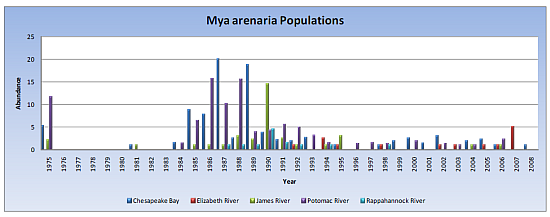Soft-Shell Clam (Mya arenaria)
Climate related factors which might influence Mya arenaria distributions:
- Water Temperature predicted to increase due to air temperature increase
- Competition from other Species better adapted to warm waters
- Phytoplankton (food source) abundance and timing of bloom
- Turbidity Leading to Smothering predicted to increase due to increased precipitation and upland development
Mya arenaria (soft-shelled clam) is widespread throughout the Chesapeake Bay and its tributaries. It is a benthic dwelling species, living in shallow waters and fine sand and sandy mud bottoms. Data for populations are from Chesapeake Bay Baywide Benthic Datasets (http://www.chesapeakebay.net/dataandtools.aspx). Absence of data may indicate absence of sampling effort or zero population.

High water temperatures can result in thermal stress and decreased reburrowing activity. Studies have shown that as M. arenaria populations decline due to thermal stress, Gemma gemma populations increase. If G. gemma can establish a population in a newly vacated area, they could prevent the settling of future M. arenaria larvae, resulting in a change in population. Data for populations are from Chesapeake Bay Baywide Benthic Datasets.
M. arenaria are temperature-sensitive and the southern limit of their range is controlled by the upper water temperatures. Temperature influences growth and reproduction. In the Chesapeake Bay, M. arenaria does not usually survive temperatures above 28 degrees C. High temperatures during the fall spawning season may be particularly harmful to the population. Ideal spawning temperatures range from around 10-14 degrees C in the spring (May-mid June) and 12-15 degrees C in the fall (late August-December). Data for populations are from Chesapeake Bay Baywide Benthic Datasets; data for water temperature are from Chesapeake Bay Institute Water Quality (1985-1982) and Chesapeake Bay Program Water Quality (1984-present)
Other potential relationships which could be affected by climate include:
Potential Relationships |
Data Available? |
Data Sets |
| Increased turbidity and bivalve distribution? | Yes |
|
| Bivalve distribution and predator distribution? | Yes |
|
| Phytoplankton abundance and bivalve distribution? | Yes |
|
| Fall water temperatures and bivalve distribution? | Yes |
|
| Bivalve distribution and eutrophication control? | Yes |
|
| Timing of phytoplankton bloom and bivalve spawning success? | No |
|
ReferencesFreitas, V., J. Campos, M. Fonds and H. Ven der Veer (2007) Potential impact of temperature change on epibenthic predator-bivalve prey interactions in temperate estuaries. Journal of Thermal Biology 32:328-340 Hall, C. (1964) Shallow-water marine climates and molluscan provinces. Ecology 45(2):226-234 Kennedy, V. and J. Mihursky (1971) Upper temperature tolerances of some estuarine bivalves. Chesapeake Science 12(4):193-204 Stickney, A. (1964) Salinity, temperature, and food requirements of soft-shell clam larvae in laboratory culture. Ecology 45(2):283-291 |

